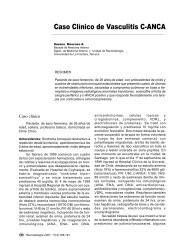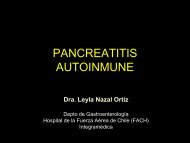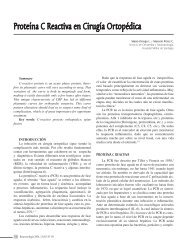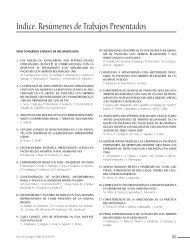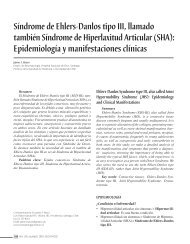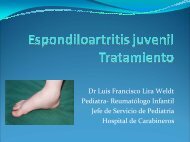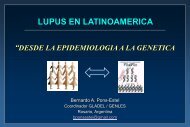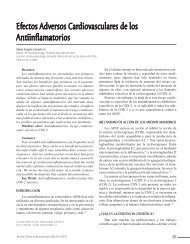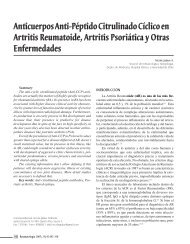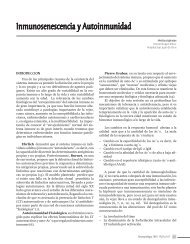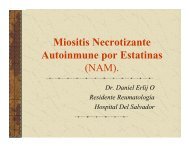Mecanismos de Acción de los Fármacos Inmunosupresores
Mecanismos de Acción de los Fármacos Inmunosupresores
Mecanismos de Acción de los Fármacos Inmunosupresores
You also want an ePaper? Increase the reach of your titles
YUMPU automatically turns print PDFs into web optimized ePapers that Google loves.
<strong>Mecanismos</strong> <strong>de</strong> Acción <strong>de</strong> <strong>los</strong> Fármacos <strong>Inmunosupresores</strong>Mecanismo <strong>de</strong> acción: Los corticoi<strong>de</strong>s difun<strong>de</strong>nfácilmente a través <strong>de</strong> la membrana plasmática, uniéndosea receptores específicos ubicados en el citoplasma celular.Éstos se encuentran normalmente unidos a proteínas chaperonas,como las <strong>de</strong> shock térmico (hsp90) y la FKbp, lascuales lo protegen y previenen su localización nuclear, yaque cubren <strong>los</strong> sitios necesarios para el transporte a través<strong>de</strong> la membrana nuclear. Una vez ocurrida la unión entreel corticoi<strong>de</strong> y su receptor, cambios en la estructura <strong>de</strong> esteúltimo <strong>de</strong>terminan la disociación <strong>de</strong> las chaperonas, conla consiguiente exposición <strong>de</strong> las señales <strong>de</strong> localizaciónnuclear, lo que <strong>de</strong>senca<strong>de</strong>na un rápido transporte <strong>de</strong>l complejoal núcleo, lugar don<strong>de</strong> se une a secuencias específicas<strong>de</strong>l DNA, conocidas como elementos <strong>de</strong> respuesta a glucocorticoi<strong>de</strong>s(GRE). Específicamente, dos moléculas <strong>de</strong>receptores <strong>de</strong> corticoi<strong>de</strong>s unidas como homodímeros sonlas que se unen a las GRE y esto <strong>de</strong>termina un aumento enla transcripción <strong>de</strong> genes (trans-activación). (3)Muchos <strong>de</strong> <strong>los</strong> genes que son activados por <strong>los</strong> corticoi<strong>de</strong>sposeen efectos anti-inflamatorios, incluyéndoseen este grupo la anexina-1 (lipocortina-1), el inhibidor <strong>de</strong>la leucoproteasa secretoria (SLPI), IL-10 y el inhibidor <strong>de</strong>NFkB (IkB-aα). También inducen la síntesis <strong>de</strong> dos proteínasque afectan la traducción <strong>de</strong> señales, como son laGILZ (glucocorticoid induced leucine zipper protein), laque inhibe el factor NF-kB y AP-1, y MKP-1 (mitogenactivated kinase phosphatase-1), que inhibe a la p28 MAPkinasa.(4-7) Sin embargo, <strong>los</strong> mayores efectos relacionadoscon el control <strong>de</strong> la inflamación serían secundarios a lainhibición <strong>de</strong> la síntesis <strong>de</strong> múltiples proteínas inflamatorias,a través <strong>de</strong> la supresión <strong>de</strong> <strong>de</strong>terminados genes,como <strong>los</strong> relacionados con la síntesis <strong>de</strong> quimioquinas,citoquinas, moléculas <strong>de</strong> adhesión celular (MAC), entreotras. Este proceso se conoce con el nombre <strong>de</strong> transrepresión(Tabla 2).Algunos <strong>de</strong> <strong>los</strong> genes inhibidos por la acción <strong>de</strong> <strong>los</strong>corticoi<strong>de</strong>s han sido relacionados con <strong>los</strong> efectos adversos<strong>de</strong>scritos para estos medicamentos (cis-represión); estosgenes están involucrados en la regulación <strong>de</strong>l eje hipotálamo-hipofisiario(pro-opiomelanocortina, factor liberador<strong>de</strong> corticotrofina), en el metabolismo óseo (osteocalcina)y en la estructura <strong>de</strong> la piel (keratina). (8)Efectos celulares: Como se mencionó, <strong>los</strong> corticoi<strong>de</strong>sejercen no sólo efectos anti-inflamatorios, sino también inmunomoduladores.Éstos incluyen la estabilización <strong>de</strong> la membranalisosomal, la supresión <strong>de</strong> la síntesis <strong>de</strong> prostaglandinas,reducción <strong>de</strong> la liberación <strong>de</strong> bradikinina e histamina y la permeabilidadcapilar. (9) A<strong>de</strong>más, reduce el número <strong>de</strong> célulasinflamatorias en <strong>los</strong> distintos tejidos, incluyendo eosinófi<strong>los</strong>,linfocitos T (LT), mastocitos y células <strong>de</strong>ndríticas (DC). (3) Loanterior sería secundario a la supresión <strong>de</strong> la producción <strong>de</strong>factores quimiotácticos y MAC y a la inhibición <strong>de</strong> la sobrevida<strong>de</strong> estos tipos celulares.TABLA 2.EFECTOS DE LOS CORTICOIDES EN LA TRANSCRIPCIÓN GÉNICA.MAC: moléculas <strong>de</strong> adhesión celularActivación <strong>de</strong> la transcripción (trans-activación)Anexina-1 (Lipocortina-1, inhibidor <strong>de</strong> la fosfolipasa A2)Receptor βb2-adrenérgicoInhibidor <strong>de</strong> la leucoproteasa secretoriaClara cell protein (CC10, inhibidor <strong>de</strong> la fosfolipasa A2)Antagonista <strong>de</strong>l receptor <strong>de</strong> IL-1IL-1 R2IkB-aαGILZMKP-1IL-10 (indirectamente)Inhibición <strong>de</strong> la transcripción (trans-represión)Citoquinas: IL-1, 2, 3, 4, 5, 6, 9, 11, 12, 13, 16, 17, 18, TNF-a, GM-CSF, SCF.Quimioquinas: IL-8, RANTES, MIP-1 aα, MCP-1, MCP-3, MCP-4 y eotaxina.MAC: ICAM-1, VCAM-1, selectina-E.Enzimas inflamatorias: INOS, COX-2, fosfolipasa A2 citoplasmática.Receptores inflamatoriosPéptidos: endotelina-1Revista Chilena <strong>de</strong> Reumatología 2008; 24(2):73-8875
<strong>Mecanismos</strong> <strong>de</strong> Acción <strong>de</strong> <strong>los</strong> Fármacos <strong>Inmunosupresores</strong>promover gran respuesta inflamatoria, punto central en lapatogénesis <strong>de</strong> la AR. Diversos agentes biológicos tienencomo blanco esta citoquina.a) Etanercept: Correspon<strong>de</strong> a una proteína <strong>de</strong> fusión,que combina la porción <strong>de</strong> unión (paratopo) <strong>de</strong>l receptorhumano tipo 2 <strong>de</strong> TNF (TNFR2) con la región Fc <strong>de</strong> laIgG1 humana. A diferencia <strong>de</strong>l TNFR1, el TNFR2 es unreceptor <strong>de</strong> membrana constitutivo presente en todos <strong>los</strong>tipos celulares, salvo en LT en reposo y hematíes, quea<strong>de</strong>más pue<strong>de</strong> ser inducido por sobreestimulación. Posee(46, 105)capacidad <strong>de</strong> unión a TNF-a y b.Su uso está aprobado en AR y artritis psoriática resistentea la terapia convencional, artritis juvenil poliarticular(105, 106)y espondiloartritis anqui<strong>los</strong>ante.b) Infliximab: Anticuerpo recombinante quiméricoque contiene secuencias <strong>de</strong>rivadas <strong>de</strong> la región Fc <strong>de</strong> laIgG1 humana y regiones variables <strong>de</strong> ratón. Se une conalta afinidad al TNF-a soluble y unido a la membrana,impidiendo la unión <strong>de</strong> ésta con su receptor. Infliximab<strong>de</strong>termina la muerte <strong>de</strong> células que expresan TNF-a através <strong>de</strong> citotoxicidad mediada por anticuerpos y <strong>de</strong>pendiente<strong>de</strong> C’.(46, 106)Fue el primer agente biológico aprobado para utilizaren enfermedad <strong>de</strong> Crohn, a<strong>de</strong>más <strong>de</strong> estar ampliamenteindicado en AR resistente y recientemente en espondiloartritisanqui<strong>los</strong>ante. (105)c) Adalimumab: Correspon<strong>de</strong> a un anticuerpo monoclonalrecombinante tipo IgG1 completamente humano,que se une específicamente y con alta afinidad al TNF-a,impidiendo la unión <strong>de</strong> éste a su receptor y lisando lascélulas que lo expresan en su membrana.Aprobado exclusivamente para el manejo <strong>de</strong> la AR(46, 105)mo<strong>de</strong>rada-severa.Efectos adversos: Los tres fármacos previamente<strong>de</strong>scritos presentan similares reacciones adversas, entrelas que <strong>de</strong>stacan las infecciones (incluyendo TBC einfecciones oportunistas), enfermeda<strong>de</strong>s <strong>de</strong>smielinizantes(esclerosis múltiple) y autoinmunes (LES, vasculitis),falla cardiaca congestiva, enfermeda<strong>de</strong>s hepáticas, cáncer,anormalida<strong>de</strong>s hematológicas (anemia aplástica y linfoma)y reacciones relacionadas con la administración <strong>de</strong>lagente. (46, 105) Se <strong>de</strong>scribe también formación <strong>de</strong> anticuerposneutralizantes (anti-agente) y no neutralizantes (ANA,anti-DNA). Para prevenir la aparición <strong>de</strong> <strong>los</strong> primeros, serecomienda el uso previo al inicio <strong>de</strong> la terapia biológica<strong>de</strong> otros inmunosupresores, <strong>los</strong> que a<strong>de</strong>más mejoran laduración <strong>de</strong> la respuesta terapéutica. (105)– Antagonista <strong>de</strong> la IL-1: Esta IL es producida pormonocitos, macrófagos y algunas células sinoviales yposee efectos inflamatorios relacionados con la inducción<strong>de</strong> la síntesis <strong>de</strong> IL-6 y COX-2. Su acción es regulada porun antagonista específico <strong>de</strong>l receptor <strong>de</strong> IL-1 (IL1Ra). Encontraste con el TNF-a, que se encuentra predominantementeen las etapas iniciales <strong>de</strong> la AR, la IL-1 es <strong>de</strong>tectadatiempo <strong>de</strong>spués <strong>de</strong>l inicio <strong>de</strong> la enfermedad, por lo cual sejustifica el uso <strong>de</strong> agentes bloqueadores <strong>de</strong> IL-1 en todaslas etapas <strong>de</strong> la AR. (106)a) Anakinra: Es el primer agente biológico que hasido <strong>de</strong>sarrollado específicamente con un receptor antagonista<strong>de</strong> la IL-1, siendo <strong>de</strong>rivado <strong>de</strong> IL-1Ra endógeno.Anakinra bloquea la actividad <strong>de</strong> la IL-1 en la membranasinovial, reduciendo la inflamación y el proceso <strong>de</strong>structivoasociado a la AR. Compite por la unión al IL-1RI conla IL-1aα y con la IL-1b. (107)Efectos adversos: En el 50%-80% <strong>de</strong> <strong>los</strong> pacientes sepresenta irritación en el sitio <strong>de</strong> inyección, generalmente<strong>de</strong> leve cuantía, y se resuelve <strong>de</strong>ntro <strong>de</strong> pocas semanas. Elriesgo <strong>de</strong> infecciones bacterianas se encuentra aumentado.Casos aislados <strong>de</strong> neutropenia y trombocitopenia reversibletambién han sido <strong>de</strong>scritos. (46)– Anticuerpos ANTI-CD20: La molécula CD20 esuna proteína hidrofóbica transmembrana, que se expresaen <strong>los</strong> linfocitos pre-B y LB maduros, a<strong>de</strong>más <strong>de</strong> la mayoría<strong>de</strong> <strong>los</strong> linfomas no-Hodgkin <strong>de</strong> células B. Regula <strong>los</strong>primeros pasos <strong>de</strong> la activación <strong>de</strong>l ciclo celular y diferenciación,actuando a<strong>de</strong>más como canal <strong>de</strong> calcio. Noexiste libre en circulación, por lo que una droga que reaccionecon CD20 no será neutralizante hasta que se une ala célula target. (108)a) Rituximab: Es un anticuerpo monoclonal quimérico(murino/humano) que reacciona con la moléculaCD20. Está formado por la región constante <strong>de</strong> laca<strong>de</strong>na kappa humana y la región variable murina <strong>de</strong>la ca<strong>de</strong>na liviana y pesada. La región constante <strong>de</strong> la(108, 109)ca<strong>de</strong>na pesada pertenece a la IgG1.Su uso está aprobado por la FDA en el tratamiento <strong>de</strong>linfoma <strong>de</strong> células B (refractario y/o recaídas); sin embargo,existe evi<strong>de</strong>ncia creciente que respalda su utilidad en AR yLES, existiendo reportes aislados en el manejo <strong>de</strong> la crioglobulinemiamixta tipo II, <strong>de</strong>rmatomiositis, granulomatosis(109, 110)<strong>de</strong> Wegener y pénfigo vulgar refractario.Mecanismo <strong>de</strong> acción: Tres diferentes mecanismoshan sido propuestos para la eliminación <strong>de</strong> <strong>los</strong> LB, <strong>los</strong> queincluyen la citotoxicidad mediada por anticuerpos, porRevista Chilena <strong>de</strong> Reumatología 2008; 24(2):73-8883
Carolina Díaz G.complemento y la estimulación <strong>de</strong> la vía <strong>de</strong> la apoptosis,lo que <strong>de</strong>termina un rápido <strong>de</strong>scenso <strong>de</strong> <strong>los</strong> LB circulantesy con esto <strong>de</strong> la producción <strong>de</strong> autoanticuerpos. (108-110)Reacciones adversas: La fiebre constituye la reacciónadversa más frecuente (43%), que pue<strong>de</strong> estar acompañada<strong>de</strong> calofríos, hipotensión ortostática (10%) y broncoespasmo(8%). Otros efectos incluyen trombocitopenia,anemia, neutropenia, <strong>de</strong>pleción <strong>de</strong> células B y aumento<strong>de</strong> la susceptibilidad a infecciones por agentes no oportunistas.Las reacciones adversas relacionadas con la administraciónparenteral son náuseas, urticaria o exantema,fatiga, cefalea, prurito, broncospasmo, disnea, angioe<strong>de</strong>ma,rinitis, vómitos, hipotensión transitoria, rubor,arritmia. Con menor frecuencia se registraron exacerbación<strong>de</strong> trastornos cardiacos preexistentes como angina einsuficiencia cardiaca. Estos efectos se observan <strong>de</strong>ntro <strong>de</strong>las dos horas <strong>de</strong> realizada la infusión parenteral y <strong>de</strong>saparecenal <strong>de</strong>scen<strong>de</strong>r la velocidad <strong>de</strong> infusión, disminuyendocon las infusiones posteriores. (108-109)Uso <strong>de</strong> drogas inmunosupresoras duranteel embarazo y la lactanciaComo ya es conocido, muchas <strong>de</strong> las enfermeda<strong>de</strong>sreumatológicas se presentan por primera vez durante elembarazo, requiriendo en la mayoría <strong>de</strong> <strong>los</strong> casos el inicio<strong>de</strong> terapia farmacológica para su control. En la Tabla 3 seresumen las indicaciones y efectos fetales <strong>de</strong> <strong>los</strong> fármacosmás usados en Chile. (41)En la Tabla 4 se comparan <strong>los</strong> fármacos inmunosupresoresmás utilizados en Chile, en relación a su potenciainmunosupresora como a <strong>los</strong> efectos adversos con el<strong>los</strong>relacionados.Entre <strong>los</strong> diversos efectos adversos inducidos por <strong>los</strong>inmunosupresores, la patología oncológica representauna <strong>de</strong> las mayores causas <strong>de</strong> morbimortalidad. Si bienen pacientes trasplantados es un riesgo que vale la penacorrer, el creciente uso <strong>de</strong> estos fármacos en pacientes notrasplantados requiere <strong>de</strong> una minuciosa evaluación <strong>de</strong>beneficios y riesgos previa prescripción <strong>de</strong> éstos. (111)Cáncer en pacientes trasplantados: El riesgo estimadoy tipo <strong>de</strong> cáncer varían entre <strong>los</strong> distintos estudios,reflejando las diferencias geográficas, distintos regímenesinmunosupresores, uso <strong>de</strong> terapias profilácticas antivirales,órgano trasplantado y tiempo <strong>de</strong> seguimiento. Los fármacosmás implicados son aquel<strong>los</strong> que provocan una intensainmunosupresión, <strong>de</strong>stacando en este grupo el Tacrolimusy el OKT3. (111)Las patologías más frecuentes son: cáncer <strong>de</strong> piel(tipo escamoso) y labios, <strong>de</strong>sór<strong>de</strong>nes linfoproliferativos(linfoma no-Hodgkin) y sarcoma <strong>de</strong> Kaposi (en poblaciónmediterránea). (111)Cáncer en pacientes no trasplantados: Se ha logrado<strong>de</strong>mostrar en estos pacientes que:– AZA se asocia con un bajo riesgo <strong>de</strong> cáncer.– Ciclofosfamida se relaciona con un aumento importante<strong>de</strong>l riesgo <strong>de</strong> cáncer vesical, cutáneo y linfoproliferativo.Estos hallazgos no se presentan en pacientes lúdicos.(111)– CsA se asocia con un incremento en el riesgo <strong>de</strong> pa<strong>de</strong>cer<strong>de</strong>sór<strong>de</strong>nes linfoproliferativos en pacientes con AR. (111)– MXT se asocia con aumento en el riesgo <strong>de</strong> neoplasiashematológicas, <strong>de</strong>stacando entre ellas el linfoma no-Hodgkin y el mieloma múltiple. (111)– Infliximab y Etanercept no han sido asociados conmayor inci<strong>de</strong>ncia <strong>de</strong> neoplasias; sin embargo, aún faltanestudios <strong>de</strong> largo plazo.CONCLUSIONESEl <strong>de</strong>scubrimiento en las últimas décadas <strong>de</strong> nuevosagentes inmunosupresores, cada vez más potentes y específicos,ha permitido la expansión y el progreso <strong>de</strong> lamedicina <strong>de</strong>l trasplante, así como también se ha logradoun mejor control y, con esto, una mejor calidad <strong>de</strong> vida <strong>de</strong><strong>los</strong> pacientes con enfermeda<strong>de</strong>s reumatológicas.Actualmente, el médico posee un gran arsenal <strong>de</strong>drogas, con diversos mecanismos <strong>de</strong> acción e indicaciones,no existiendo, lamentablemente, un criterio único <strong>de</strong>indicación, por lo que se <strong>de</strong>be siempre sopesar <strong>los</strong> riesgosasociados a una <strong>de</strong>terminada terapia en relación a <strong>los</strong>beneficios esperados. Es así como el efecto beneficioso<strong>de</strong> prevenir el <strong>de</strong>sarrollo <strong>de</strong>l rechazo y el curso natural<strong>de</strong> la enfermedad se ve contrarrestado por <strong>los</strong> múltiplesy potencialmente graves efectos secundarios asociados aestos medicamentos. La dosis excesiva <strong>de</strong> inmunosupresoresconlleva la aparición <strong>de</strong> infecciones oportunistas yel <strong>de</strong>sarrollo <strong>de</strong> neoplasias malignas. La toxicidad directaque se <strong>de</strong>riva <strong>de</strong> <strong>los</strong> mismos constituye uno <strong>de</strong> <strong>los</strong> mayoresproblemas que afectan a la supervivencia y a la calidad <strong>de</strong>vida <strong>de</strong>l paciente; conduce a graves patologías, como lahipertensión arterial, la hiperlipi<strong>de</strong>mia, la diabetes mellitus,la insuficiencia renal irreversible y la pérdida <strong>de</strong> masaósea.Es <strong>de</strong> esperar que en <strong>los</strong> próximos años continúen apareciendonuevas drogas inmunosupresoras, más específicasy ojalá al alcance <strong>de</strong> todos <strong>los</strong> pacientes.84Revista Chilena <strong>de</strong> Reumatología 2008; 24(2):73-88
<strong>Mecanismos</strong> <strong>de</strong> Acción <strong>de</strong> <strong>los</strong> Fármacos <strong>Inmunosupresores</strong>TABLA 3.USO DE DROGAS INMUNOSUPRESORAS DURANTE EL EMBARAZO Y LA LACTANCIA.RCIU: restricción <strong>de</strong>l crecimiento intrauterinaDroga Categoría Efectos fetales Uso en lactancia RecomendacionesFDAGlucocorticoi<strong>de</strong>s B Fisura palatina si hay Sí, amamantar 4 hrs Evaluar necesidad <strong>de</strong> dosisexposición en 1 er trimestre <strong>de</strong>spués <strong>de</strong> la última dosis <strong>de</strong> estrés, evitar durante1 er trimestreAINE B Riesgo <strong>de</strong> hemorragia fetal, Sí, con incremento <strong>de</strong> Discontinuar 6-8 semanascierre prematuro <strong>de</strong>l ductus potencial riesgo <strong>de</strong> previo al parto, ojalá en laarterioso ictericia y kernicterus semana 32Inhibidores C Riesgo <strong>de</strong> hemorragia fetal, Datos insuficientes Discontinuar 6-8 semanas previoCOX-2 cierre prematuro <strong>de</strong> ductus al parto, ojalá en la semana 32arteriosoHidroxicloroquina C Probablemente no Sí Pue<strong>de</strong> continuarse duranteembarazoMetotrexato X Anormalida<strong>de</strong>s craneales, No Discontinuar 4 meses previo a la<strong>de</strong>fectos <strong>de</strong> extremida<strong>de</strong>s,concepción, suplementar conanormalida<strong>de</strong>s <strong>de</strong>l SNCácido fólico esos 4 meses ydurante el embarazoLeflunamida X Embriotóxico No Colestiramina 8 g, 3 vecesal día por 11 días, con nivelesplasmáticos menores que0,02 mg/L en 2 tests separadosy esperar 3 cic<strong>los</strong> previo a laconcepciónSulfasalazina B, D Probablemente no Sí Pue<strong>de</strong> continuarse duranteembarazoAzatioprina D RCIU, leucopenia neonatal, No Usar con precaución si sehipogamaglobulinemia,requiere; consi<strong>de</strong>rar disminuirinfecciones (CMV y Gramdosis a las 32 semanasnegativos)Ciclofosfamida D Embriopatía con déficit <strong>de</strong>l No Evitar durante el embarazo,crecimiento, craneosinostosis,especialmente durante el<strong>de</strong>fectos craneofaciales y <strong>de</strong>1 er trimestreextremida<strong>de</strong>s distalesCic<strong>los</strong>porina A C Desarrollo y maduración No Uso con precaución si se requiereanormal <strong>de</strong> LT, LB, NKsuprimir la actividadMicofenolato C Teratogénico, malformaciones No Evitar durante el embarazomofetilcraneofaciales y extremida<strong>de</strong>sdistalesAntagonistas TNF B Datos insuficientes Datos insuficientes, no Uso con precaución si se requiereAnakinra B Datos insuficientes, no Datos insuficientes, no Uso con precaución si setoxicidad en estudios conrequiere suprimir la actividadratonesRituximab C Datos insuficientes, casos Datos insuficientes, no Evitar durante el embarazoreportados <strong>de</strong> linfo ygranulocitopeniaRevista Chilena <strong>de</strong> Reumatología 2008; 24(2):73-8885
Carolina Díaz G.TABLA 4.COMPARACIÓN ENTRE LAS REACCIONES ADVERSAS PRODUCIDAS POR LOSDISTINTOS INMUNOSUPRESORES.FármacosRAM Cic<strong>los</strong>porina Tacrolimus Sirolimus Azatioprina Micofenolato Corticoi<strong>de</strong>smofetilPotencia +++ ++++ +++ + ++ +inmunosupresoraNefrotoxicidad ++ ++ - - - -Neurotoxicidad + ++ - - - -Hirsutismo ++ - - - - ++Rash cutáneo - - + - - -Diabetogénesis + ++ - - - ++Supresión medular - - + + + -Hepatotoxicidad + + + + - -Diarrea - - + - ++ -REFERENCIAS BIBLIOGRÁFICAS1. Taylor A, Watson C, Bradley J. Immunosuppressive agents in solid organtransplantation: Mechanism of action and therapeutic efficacy. ClinicalReviews in Oncology/Hematology 2005; 56:23-46.2. Saklatvala J. Glucocorticoids: do we know how they work?. ArthritisResearch 2002; 4:146-150.3. Barnes P. Molecular mechanism and cellular effects of glucocorticosteroids.Immnunol Allergy Clin N Am 2005; 25:451-468.4. Hall SE, Lim S, Wither<strong>de</strong>n IR, et al. Lung type II cell and macrophageannexin I release: differential effects of two glucocorticoids. Am J Physiol1999; 276:L114-21.5. Newton R, Hart LA, Stevens DA, et al. Effect of <strong>de</strong>xamethasone on interleukin-1b-(IL-1b)-inducednuclear factor-kB (NF-kB) and kB-<strong>de</strong>pen<strong>de</strong>nttranscription in epithelial cells. Eur J Biochem 1998; 254(1):81-9.6. Mittelstadt PR, Ashwell JD. Inhibition of AP-1 by the glucocorticoid-inducibleprotein GILZ. J Biol Chem 2001; 276(31):29603-10.7. Lasa M, Abraham SM, Boucheron C, et al. Dexamethasone causes sustaine<strong>de</strong>xpression of mitogen-activated protein kinase (MAPK) phosphatase1 and phosphatase-mediated inhibition of MAPK p38. Mol CellBiol 2002; 22(22):7802-11.8. Dostert A, Heinzel T. Negative glucocorticoid receptor response elementsand their role in glucocorticoid action. Curr Pharm Des 2004;10(23):2807-16.9. Adcock IM, Ito K. Molecular mechanisms of corticosteroid actions. MonaldiArch Chest Dis 2000; 55(3):256-66.10. Patel A, Swerlick R, McCall C. Azathioprine in <strong>de</strong>rmatology: The past, thepresent, and the future. J Am Acad Dermatol 2006; 55(3):369-89.11. Hoffmann M, Rychlewski J, Chrzanowska M, Hermann T. Mechanismof activation of an immunosuppressive drug: azathioprine. Quantumchemical study on the reaction of azathioprine with cysteine. J AmChem Soc 2001; 123:6404-9.12. Maltzman JS, Koretzky GA. Azathioprine: old drug, new actions. J ClinInvest 2003; 111:1122-4.13 Fournier C, Bach MA, Dar<strong>de</strong>nne M, Bach JF. Selective action of azathioprineon T cells. Transpl Proc 1973; 5:523-6.14. Galanaud P, Crevon MC, Erard D, Wallon C, Dormont J. Two processes forB-cell triggering by T-in<strong>de</strong>pen<strong>de</strong>nt antigens as evi<strong>de</strong>nced by the effectof azathioprine. Cell Immunol 1976; 22:83-92.15. Voogd CE. Azathioprine, a genotoxic agent to be consi<strong>de</strong>red non-genotoxicin man. Mutat Res 1989; 221:133-52.16. Schwartz R, Dameshek W. Drug-induced immunological tolerance.Nature 1959; 183(4676):1682-3.17. Belgi G, Friedmann PS. Traditional therapies: glucocorticoids, azathioprine,methotrexate, hydroxyurea. Clin Exper Dermatol 2002; 27:546-54.18. Levy J, Barnett EV, MacDonald NS, Klinenberg JR, Pearson CM. The effectof azathioprine on gammaglobulin synthesis in man. J Clin Invest 1972;51:2233-8.19. Gorski A, Korczak-Kowalska G, Nowaczyk M, Paczek L, Gaciong Z. Theeffect of azathioprine on terminal differentiation of human B lymphocytes.Immunopharmacology 1983; 6:259-66.20. Lowry PW, Franklin CL, Weaver AL, Szumlanski CL, Mays DC, Loftus EV, etal. Leucopenia resulting from a drug interaction between azathioprineor 6-mercaptopurine and mesalamine, sulphasalazine, or balsalazi<strong>de</strong>.Gut 2001; 49:656-64.21. Mayer D, Kushwaha S. Transplant immunosuppressant agents andtheir role in autoimmune rheumatic diseases. Curr O Rheumatol 2003;15:219-225.22. Busca A, Saroglia EM, Lanino E, et al. Mycophenolate mofetil (MMF) astherapy for refractory chronic GVHD (cGVHD) in children receiving bonemarrow transplantation. Bone Marrow Transplant 2000; 25:1067-1071.23. Basara N, Blau WI, Kiehl MG, et al. Mycophenolate mofetil for the prophylaxisof acute GVHD in HLA-mismatched bone marrow transplantpatients. Clin Transplant 2000; 14:121-126.24. Dooley MA, Cosio FG, Nachman PH, et al. Mycophenolate mofetil therapyin lupus nephritis: clinical observations. J Am Soc Nephrol 1999;10:833-839.25. Wallman L, Stewart G, Chapman J, et al. Mycophenolate mofetil fortreatment of refractory lupus nephritis: four pilot cases. Aust N Z J Med2000; 30:712-715.86Revista Chilena <strong>de</strong> Reumatología 2008; 24(2):73-88
<strong>Mecanismos</strong> <strong>de</strong> Acción <strong>de</strong> <strong>los</strong> Fármacos <strong>Inmunosupresores</strong>26. Hu W, Liu Z, Chen H, et al. Mycophenolate mofetil vs cyclophosphami<strong>de</strong>therapy for patients with diffuse proliferative lupus nephritis. ChinMed J (Engl) 2002; 115:705-70927. Nowack R, Göbel U, Klooker P, et al. Mycophenolate mofetil for maintenancetherapy of Wegener’s granulomatosis and microscopic polyangiitis:a pilot study in 11 patients with renal involvement. J Am Soc Nephrol1999; 10:1965-1971.28. Schnei<strong>de</strong>r C, Gold R, Schafers M, et al. Mycophenolate mofetil in thetherapy of polymyositis associated with a polyautoimmune syndrome.Muscle Nerve 2002; 25:286-288.29. Gelber AC, Nousari HC, Wigley FM. Mycophenolate mofetil in the treatmentof severe skin manifestations of <strong>de</strong>rmatomyositis: a series of 4cases. J Rheumatol 2000; 27:1542-1545.30. Tausche AK, Meurer M. Mycophenolate mofetil for <strong>de</strong>rmatomyositis.Dermatology 2001; 202:341-343.31. Schiff MH, Goldblum R, Rees MMC. 2-Morpholino-ethyl mycophenolicacid (ME-MPA) in the treatment of refractory rheumatoid arthritis (RA).Arthritis Rheum 1990; 33:S155.32. Grundmann-Kollmann M, Mooser G, Schrae<strong>de</strong>r P, et al. Treatment ofchronic plaque-stage psoriasis and psoriatic arthritis with mycophenolatemofetil. J Am Acad Dermatol 2000; 42:835-837.33. Allison AC, Eugui EM. Purine metabolism and immunosuppressiveeffects of mycophenolate mofetil (MMF). Clin Transplant 1996;10:77-84.34. Allison A, Eugui E. Mycophenolate mofetil and its mechanism of action.Immunopharmacology 2000; 47:85-118.35. Chang C-CJ, Aversa, G, Punnonen≠ J, Yssel H, <strong>de</strong> Vries J. Brequinarsodium, mycophenolic acid, and cyc<strong>los</strong>porine A inhibit different stagesof IL-4 or IL-3-induced human IgG4 and IgE production in vitro. Ann N YAcad Sci 1993; 696:108-122.36. Weimer R, Melk A, Daniel V, et al. Monocyte responses in patients withchronic renal transplant rejection: beneficial effects of MMF-basedimmunosuppression. Transplantation 1999; 67, 27. (Abstr.)37. Cohn RG, Mirkovich A, Caulfield J, Eugui EM, 1999. Apoptosis of humanactivated peripheral T-cells and Tlymphocytic and promonocytic celllines induced by mycophenolic acid, the active metabolite of CellCept.In: The Sixth Basic Sciences Symposium of the Transplantation Society,Monterey, CA. p. 173.38. Pardo-Mindan FJ, Erraste P, Panizo A, et al. Decrease of apoptosis ratein patients treated with mycophenolate mofetil. Nephron 1999; 82:232-237.39. Azuma H, Bin<strong>de</strong>r J, Heeman U, et al. Effects of RS61443 on functionaland morphological changes in chronically rejecting rat kidney allografts.Transplantation 1995; 59:460-466.40. Verham R, Meek TD, Hedstrom L, Wang CC. Purification, characterizationand kinetic analysis of inosine-5X monophosphate <strong>de</strong>hydrogenaseof Trichomonas foetus. Mol Biochem Parasitol 1987; 24:1-12.41. Temprano K, Bandlamudi R, Moore T. Antirheumatic drugs in pregnancyand lactation. Sem arthritis and rheumatism 2005; 35:112-21.42. Olsen NJ, Strand V, Kremer JM: Leflunomi<strong>de</strong> for the treatment of rheumatoidarthritis. Bull Rheum Dis 1999; 48:1-4.43. Remer CF, Weisman MH, Wallace DJ. Benefits of leflunomi<strong>de</strong> in systemiclupus erythematosus: a pilot observational study. Lupus 2001; 10:480-483.44. Williams JW, Mital D, Chong A, et al. Experiences with leflunomi<strong>de</strong> insolid organ transplantation. Transplantation 2002; 73:358-366.45. Kremer JM. Methotrexate and leflunomi<strong>de</strong>: biochemical basis for combinationtherapy in the treatment of rheumatoid arthritis. Semin ArthritisRheum 1999; 29:14-26.46. Wood A. New drugs for rheumatoid arthritis. NEJM 2004; 350(21):2167-79.47. Burger D, Begue-Pastor N, Benavent S, et al. The active metabolite ofleflunomi<strong>de</strong>, A77 1726, inhibits the production of prostaglandin E(2),matrix metalloproteinase 1 and interleukin 6 in human fibroblast-likesynoviocytes. Rheumatology (Oxford) 2003; 42:89-96.48. Schuna AA, Megeff C. New drugs for the treatment of rheumatoidarthritis. Am J Health Syst Pharm 2000; 57:225-34.49. Weinblatt ME, Kremer JM, Coblyn JS, et al. Pharmacokinetics, safety,and efficacy of combination treatment with methotrexate and leflunomi<strong>de</strong>in patients with active rheumatoid arthritis. Arthritis Rheum 1999;42:1322-8.50. Kremer JM, Genovese MC, Cannon GW, et al. Concomitant leflunomi<strong>de</strong>therapy in patients with active rheumatoid arthritis <strong>de</strong>spite stable dosesof methotrexate: a randomized, double-blind, placebo-controlled trial.Ann Intern Med 2002; 137:726-33.51. Taylor PC, Peters AM, Paleolog E, et al. Reduction of chemokine levelsand leukocyte traffic to joints by tumor necrosis factor alpha blocka<strong>de</strong>in patients with rheumatoid arthritis. Arthritis Rheum 2000; 43:38-47.52. Auer J, Hinterreiter M, Allinger S, Kirchgatterer A, Knoflach P. Severe pancytopeniaafter leflunomi<strong>de</strong> in rheumatoid arthritis. Acta Med Austriaca2000; 27:131-2.53. Marchesoni A, Arreghini M, Panni B, Battafarano N, Uziel L. Life-threateningreversible bone marrow toxicity in a rheumatoid arthritis patientswitched from leflunomi<strong>de</strong> to infliximab. Rheumatology (Oxford) 2003;42:193-4.54. Aventis statement in response to reported cases of interstitial pneumonitisin Japan. (Accessed April 26, 2004, at http://www.arava.com/docs/Japan IP Arava.pdf.)55. Matsuda S, Koyasu S. Mechanism of action of cyc<strong>los</strong>porine. Immunopharmacology2000; 47:119-25.56. Borel JF, Feurer C, Gubler HV, Stahelin H. Biological effect of cyc<strong>los</strong>porinA: a new anti-lymphocytic agent. Agents Actions 1976; 6:468-475.57. Temekonidis TI, Georgiadis AN, Alamanos Y, et al. Infliximab treatmentin combination with cyc<strong>los</strong>porin A in patients with severe refractoryrheumatoid arthritis. Ann Rheum Dis 2002; 61:822-825.58. Tam LS, Li EK, Szeto CC, et al. Treatment of membranous lupus nephritiswith prednisone, azathioprine and cyc<strong>los</strong>porin A. Lupus 2001; 10:827-829.59. Filaci G, Cutolo M, Basso M, et al. Long-term treatment of patientsaffected by systemic sclerosis with cyc<strong>los</strong>porin A. Rheumatology(Oxford) 2001; 40:1431-1432.60. Ghez D, Westeel PF, Henry I, et al. Control of a relapse and induction oflong-term remission of Wegener’s granulomatosis by cyc<strong>los</strong>porine. AmJ Kidney Dis 2002; 40:E6.61. Raman V, Kim J, Sharkey A, et al. Response of refractory Kawasaki diseaseto pulse steroid and cyc<strong>los</strong>porin A therapy. Pediatr Infect Dis J 2001;20:635-637.62. Rao A, Luo C, Hogan PG. Transcription factors of the NF-AT family: regulationand function. Annu Rev Immunol 1997; 15:707-747.63. Stepkowski S. Molecular targets for existing and novel immunosuppressivedrugs. Expert reviews in molecular medicine 2000; 21:1-23.64.Matsuda S, Moriguchi T, Koyasu S, Nishida E. T lymphocyte activationsignals for interleukin-2 production involve activation of MKK6-p38 andMKK7-SAPKrJNK signaling pathways sensitive to cyc<strong>los</strong>porin A. J BiolChem 1998; 273:12378-12382.65. Shibasaki F, Hallin U, Uchino H. Calcineurin as a multifunctional regulator.J Biochem (Tokyo) 2002; 131(1):1-15.66. Masuda S, Inui K. An up-date review on individualized dosage adjustmentof calcineurin inhibitors in organ transplant patient. Pharmacology& Therapeutics 2006; 112:184-98.67. Levy G, Villamil F, Samuel D, Sanjuan F, Grazi GL, Wu Y, et al. Resultsof lis2t, a multicenter, randomized study comparing cyc<strong>los</strong>porine microemulsionwith C2 monitoring and tacrolimus with C0 monitoring in <strong>de</strong>novo liver transplantation. Transplantation 2004; 77:1632-1638.68. Stefoni S, Midtved K, Cole E, Thervet E, Cockfield S, Buchler M,et al. Efficacy and safety outcomes among <strong>de</strong> novo renal transplantRevista Chilena <strong>de</strong> Reumatología 2008; 24(2):73-8887
Carolina Díaz G.recipients managed by C2 monitoring of cyc<strong>los</strong>porine a microemulsion:results of a 12-month, randomized, multicenter study. Transplantation2005; 79:577-583.69. Dumont F. FK506, an immunosuppressant targeting calcineurin function.Curr Med Chemistry 2000; 7:731-48.70. Taylor DO, Barr ML, Meiser BM, et al. Suggested gui<strong>de</strong>lines for the useof tacrolimus in cardiac transplant recipients. J Heart Lung Transplant2001; 20:734-738.71. Onsager DR, Canver CC, Jahania MS, et al. Efficacy of tacrolimus in thetreatment of refractory rejection in heart and lung transplant recipients.J Heart Lung Transplant 1999; 18:448-455.72. Garrity ER Jr, Hertz MI, Trulock EP, et al. Suggested gui<strong>de</strong>lines for the useof tacrolimus in lung-transplant recipients. J Heart Lung Transplant 1999;18:175-176.73. Gruessner RW. Tacrolimus in pancreas transplantation: a multicenteranalysis. Tacrolimus Pancreas Transplant Study Group. Clin Transplant1997; 11:299-312.74. Furst DE, Saag K, Fleischmann MR, et al. Efficacy of tacrolimus in rheumatoidarthritis patients who have been treated unsuccessfully withmethotrexate: a six-month, double blind, randomized, dose-rangingstudy. Arthritis Rheum 2002; 46:2020-2028.75. Duddridge M, Powell RJ. Treatment of severe and difficult cases of systemiclupus erythematosus with tacrolimus. A report of three cases. AnnRheum Dis 1997; 56:690-692.76. Morton SJ, Powell RJ. Cyc<strong>los</strong>porin and tacrolimus: their use in a routineclinical setting for sclero<strong>de</strong>rma. Rheumatology 2000; 39:865-869.77. Sloper CM, Powell RJ, Dua HS. Tacrolimus (FK506) in the treatmentof posterior uveiitis refractory to cyc<strong>los</strong>porine. Ophthalmology 1999;106:723-728.78. Kilmartin DJ, Forrester JV, Dick AD. Tacrolimus (FK506) in failed cyc<strong>los</strong>porineA therapy in endogenous posterior uveiitis. Ocul Immunol Inflamm1998; 6:101-109.79. Pilmore HL, Faire B, Dittmer I. Tacrolimus for treatment of gout in renaltransplantation: two case reports and review of the literature. Transplantation2001; 72:1703-1705.80. Siekierka JJ, Hung SH, Poe M, Lin CS, Sigal NH. A cytosolic binding proteinfor the immunosuppressant FK506 has peptidyl-prolyl isomeraseactivity but is distinct from cyclophilin. Nature 1989; 341:755-757.81. Hamawy M, Knechtle S. An overview of the actions of cyc<strong>los</strong>porine andFK506. Transplantation Reviews 2003; 17(4):165-71.82. Lazzaro C, McKechnie T, & McKenna M. Tacrolimus versus cyc<strong>los</strong>porinin renal transplantation in Italy: cost-minimisation and costeffectivenessanalyses. J Nephrol 2002; 15:580-588.83. Radovancevic B, El-Sabrout R, Thomas C, et al. Rapamycin reduces rejectionin heart transplant recipients. Transplant Proc 2001; 33:3221-3222.84. Winters GL, McManus BM. Consistencies and controversies in the applicationof the International Society for Heart and Lung Transplantationworking formulation for heart transplant biopsy specimens. J HeartLung Transplant 1996; 15:728-735.85. Odorico JS, Sollinger HW. Technical and immunosuppressive advancesin transplantation for insulin-<strong>de</strong>pen<strong>de</strong>nt diabetes mellitus. World J Surg2002; 26:194-211.86. Nishida S, Pinna A, Verzaro R, et al. Sirolimus (rapamycin)-based rescuetreatment following chronic rejection after liver transplantation. TransplantProc 2001; 33:1495.87. Hardinger KL, Cornelius LA, Trulock EP III, et al. Sirolimus-induced leukocytoclasticvasculitis. Transplantation 2002; 74:739-743.88. Mita MM, Mita A, Rowinsky EK. The molecular target of rapamycin(mTOR) as a therapeutic target against cancer. Cancer Biol Ther 2003;2(4 Suppl. 1):S169-77.89. Kuo CJ, et al. Rapamycin selectively inhibits interleukin-2 activation ofp70 S6 kinase. Nature 1992; 358:70-73.90. Montalbano M, Neff GW, Yamashiki N, et al. A retrospective reviewof liver transplant patients treated with sirolimus from a single center:an analysis of sirolimus-related complications. Transplantation 2004;78(2):264-8.91. Kahan BD, Stepkowski SM, Napoli KL, Katz SM, Knight RJ, Van Buren C.The <strong>de</strong>velopment of sirolimus: The University of Texas-Houston experience.Clin Transpl 2000:145-58.92. Haydar AA, Denton M, West A, Rees J, Goldsmith DJ. Sirolimus-inducedpneumonitis: three cases and a review of the literature. Am J Transplant2004; 4(1):137-9.93. Kimball PM, Kerman RH, and Kahan BD. Rapamycin and cyc<strong>los</strong>porineproduce synergistic but noni<strong>de</strong>ntical mechanisms of immunosuppression.Transplant Proc 1991; 23:1027-1028.94. Wang X, Zhang J, Xu T. Cyclophosphami<strong>de</strong> as a potent inhibitor of tumorthioredoxin reductase in vivo. Toxicology and applied pharmacology2007; 218:88-95.95. Van Beek M, Piette W. Antimalarials. Dermatologic Clinics 2001; 19(1):147-60.96. Homewood CA, Warhurst DC, Peters W, et al. Lysosomes, pH and theanti-malarial action of chloroquine. Nature 1972; 235:50-52.97. Ferrante A, Rowan-Kelly B, Seow WK, et al. Depression of humanpolymorphonuclear leucocyte function by antimalarial drugs. Immunology1986; 58:125-130.98. Fox R. Anti-malarial drugs: Possible mechanisms of action in autoimmunedisease and prospects for drug <strong>de</strong>velopment. Lupus 1996;5(suppl 1):S4-S10.99. Davis MI, Woolf AD. Role of antimalarials in rheumatoid arthritis – theBritish experience. Lupus 1996; 5(suppl 1):S37-S40.100. Dubois EL. Antimalarials in the management of discoid and systemiclupus erythematosus. Semin Arthritis Rheum 1978; 8:33-51.101. Genestier L, Paillot R, Quemeneur L, Izeradjene K, Revillard JP. Immunopharmacology2000; 47:247-257.102. Chan E, Cronstein B. Molecular action of Methotrexate in inflammatorydiseases. Arthritis Research 2002; 4 (4):266-73.103. Bathon JM, Martin RW, Fleischmann RM, Tesser JR, Schiff MH, KeystoneEC, Genovese MC, Wasko MC, Moreland LW, Weaver AL, Markenson J,Finck BK. A comparison of etanercept and methotrexate in patients withearly rheumatoid arthritis. NEngl J Med 2000; 343:1586-1593.104. Swierkot J, Szechinski J. Methotrexate in rheumatoid arthritis. PharmacologicalReports 2006; 58:473-492.105. Atzeni F, Turiel M, Capsoni F, Doria A, Meroni P, Sarzi-Puttini P. Autoimmunityand anti-TNF-aα agents. Ann N York aca<strong>de</strong>my of science 2005;1051(1):559-69.106. Taylor P. Anti-tumor necrosis factor therapies. Curr Opin Rheumatol2001; 13:164-69.107. Dayer J, Feige U, Edwards C, Burger D. Anti-interleukin-1 therapy in rheumaticdiseases. Curr Opin Rheumatol 2001; 13:170-76.108. Waugh J, Perry C. Anakinra. A review of its use in the management ofrheumatoid arthritis. Biodrugs 2005; 19(3):189-202.109. Pescovitz M. Rituximab, an anti-CD20 monoclonal antibody: History andmechanism of action. Am J Transplantation 2006; 6:859-66.110. Chambers S, Isenberg D. Anti-B cell therapy (Rituximab) in the treatmentof autoimmune diseases. Lupus 2005; 14:210-14.111. Vial T, Descotes J. Immunosuppressive drugs and cancer. Toxicology2003; 185:229-40.88Revista Chilena <strong>de</strong> Reumatología 2008; 24(2):73-88




